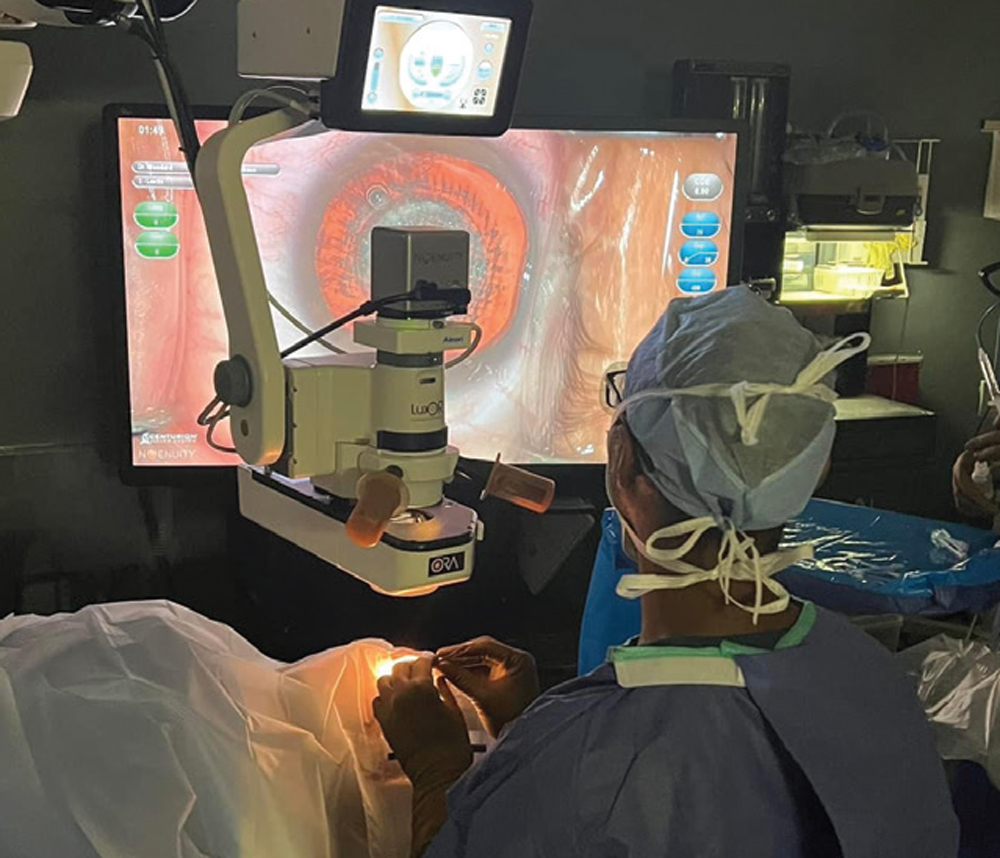 |
Q:
My high-volume cataract surgeon is young but having early symptoms of a pinched nerve due to looking down through a microscope all day. Could 3D surgery have some big advantages?
A:
Over the past few years, 3D visualization systems have been developed that allow anterior and posterior segment surgeries to be performed while viewing a large 55” 4K monitor with 3D glasses rather than looking through a microscope. The Alcon NGenuity and Zeiss Artevo are the two systems in the United States that provide markedly enhanced depth of focus compared with using oculars on a traditional microscope.
“Though it may seem challenging to change from operating with oculars to looking at a monitor, most surgeons feel that it is an easy adjustment that does not require many procedures to feel comfortable,” according to Lawrence Woodard, MD, of Omni Eye Services of Atlanta.
The benefit of viewing the eye on a large, high dynamic range monitor is that the detail of all the ocular structures is significantly improved due to the added size and clarity of the tissues visible on the monitor. “This intuitively will lead to more precise surgery with the potential for fewer complications,” says Dr. Woodard.
 |
|
3D surgery improves visualization and comfort. Click image to enlarge. |
Visualize and Follow Through
Improving visibility can give surgeons much more confidence when performing procedures, which may increase efficiency while also allowing more consistency from case to case. “The cornea, iris, anterior capsule and posterior capsule are all clearly in focus while I am working on the cataract,” Dr. Woodard says. “It is so much more accurate than 2D surgery through the oculars of a microscope, where one must rely on other cues to gauge depth within the eye.”
One of the biggest challenges during cataract surgery is identifying the thickness of the cataract. “This is critical because an error in judging the location of the posterior capsule can lead to a rupture of the capsule with vitreous prolapse into the anterior chamber, increasing the risk of undesired complications such as cystoid macular edema, retinal detachment and endophthalmitis,” Dr. Woodard notes. Any technology that could lessen the potential for complications would be welcome by surgeons.
An OR Aid
These 3D systems also allow surgeons to see pertinent information on the monitor during surgery. Parameters such as current ultrasound energy and fluid usage are visible in real-time, providing important feedback during the procedure. The surgeon can also view video overlays, which identify the axis of placement of a toric intraocular lens (IOL), crosshairs for centration of a multifocal IOL and data from intraoperative aberrometry. In addition, information from the clinic’s EHR (such as corneal topography, A-scans and OCTs) will be visible on demand on the monitor for the surgeon to view before or during the procedure.
Perhaps the most important benefit to 3D visualization is the dramatic impact that it has on surgeon comfort during a day in the operating room. Traditionally, surgeons must maintain the head and neck in a stationary position for multiple hours during the day while looking through the oculars of the surgical microscope. This continues week after week, month after month and year after year. The cumulative effect of this unnatural positioning is damage to the musculoskeletal system. Specifically, degenerative cervical disc disease and spinal stenosis are quite common in surgeons who operate frequently.
By no longer requiring surgeons to look through oculars, 3D systems significantly reduce the stress on the head and neck areas during surgery. The surgeon can sit in a more ergonomically neutral position while also enjoying the benefit of having a surgical chair with back support. This not only decreases stress on the neck and shoulders but also relieves pressure on the lower back that drastically reduces surgeon fatigue. These factors will prolong the longevity of a surgeon’s career while simultaneously improving quality of life.
Dr. Ajamian is the center director of Omni Eye Services of Atlanta. He currently serves as general chairman of the education committee for SECO International and is vice president of the Georgia State Board of Optometry. He has no financial interests to disclose.

